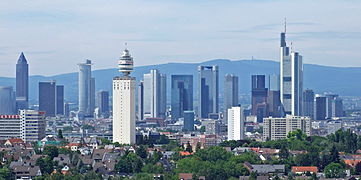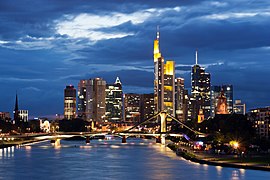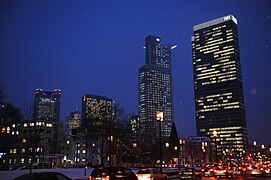Frankfurt's financial district
The Frankfurt banking district is an inner-city area of Frankfurt am Main in which a large number of banks, insurance companies and other financial institutions are located. The banking district is not an independent district and therefore has no fixed borders. In general, parts of the western inner city , the eastern station district and the south- west end are assigned to the banking district. Most of the city's high-rise buildings are located here and this is also where several major German banks ( Deutsche Bank , Commerzbank , DZ Bank , Landesbank Hessen-Thuringia ) and the representative offices of numerous foreign institutions are located.
location
The center of the banking district is formed by the area on both sides of the Gallus and Taunusanlage as well as along the Neue Mainzer Straße , Junghofstraße, Neue Schlesingergasse, Große Gallusstraße and Kaiserstraße . Furthermore, the area on both sides of the Mainzer Landstrasse from the Taunusanlage to the Platz der Republik and the Bockenheimer Landstrasse from the Opernplatz to the banking district, the transitions to the residential development of the Westend and the Bahnhofsviertel as well as the Europaviertel at the Friedrich-Ebert-Anlage are fluid.

Well-known banks
Well-known credit institutions based in Frankfurt's banking district include:
| Credit institution | building | Street | district |
|---|---|---|---|
| Bank of America | Main Tower | Neue Mainzer Strasse 52–58 | Downtown |
| Bank of China | Westend Duo | Bockenheimer Landstrasse 24 | Westend-South |
| Bank of Communications | Office building at the Alte Oper | Neue Mainzer Strasse 69–75 | Downtown |
| Bank of Scotland | Japan Center | Taunustor 2 | Downtown |
| Metzler Bank | Lower main system 1 | Bahnhofsviertel | |
| Berenberg Bank | BoLa 25 | Bockenheimer Landstrasse 25 | Westend-South |
| BHF bank | BHF Bank high-rise | Bockenheimer Landstrasse 10 | Westend-South |
| BNP Paribas | Europa-Allee 12 | Westend-South | |
| Commerzbank |
Commerzbank Tower Gallileo |
Große Gallusstraße 17–19 Gallusanlage 7 |
Downtown station district |
| Crédit Agricole | Main Building | Taunusanlage 14-19 | Westend-South |
| Credit Suisse | Taunus Tower | Taunustor 1 | Downtown |
| DekaBank Deutsche Girozentrale |
Trianon Skyper |
Mainzer Landstrasse 16–24 Taunusanlage 1 |
Westend-Süd Bahnhofsviertel |
| Deutsche Bank |
Deutsche Bank skyscraper
Deutsche Bank Campus |
Taunusanlage 12
Mainzer Landstrasse |
Westend-South
Westend-Süd |
| DZ Bank |
Westendstrasse 1 City House I. |
Westendstrasse 1 Platz der Republik 6 |
Westend-Süd Westend-Süd |
| European Central Bank |
Eurotower Japan Center New building for the European Central Bank |
Willy-Brandt-Platz 2 Taunustor 2 Sonnemannstraße 20 |
Downtown downtown Ostend |
| HSBC Trinkaus | Skyper | Taunusanlage 1 | Bahnhofsviertel |
| Houlihan Lokey | Skyper | Taunusanlage 1 | Bahnhofsviertel |
| ICICI Bank | Mainzer Landstrasse 69 | Bahnhofsviertel | |
| JPMorgan Chase & Co. | Taunus Tower | Taunustor 1 | Downtown |
| Landesbank Hessen-Thuringia | Main Tower | Neue Mainzer Strasse 52–58 | Downtown |
| Merrill Lynch | Main Tower | Neue Mainzer Strasse 52–58 | Downtown |
| Mizuho Financial Group | Taunus Tower | Taunustor 1 | Downtown |
| Morgan Stanley | OMNITURM | Great Gallusstrasse 18 | Downtown |
| Nordea | Westend Windows | Bockenheimer Landstrasse 33-35 | Westend-South |
| SEB | Stephanstrasse 14 | Downtown | |
| Société Générale | Garden Tower | Neue Mainzer Strasse 46-50 | Downtown |
| The Bank of Tokyo-Mitsubishi UFJ | Junghofstrasse 24 | Downtown | |
| UBS | Opera Tower | Bockenheimer Landstrasse 2-4 | Westend-South |
| Unicredit Bank | Taunus Tower | Taunustor 1 | Downtown |
Eurotower of the ECB on Willy-Brandt-Platz
Nightly skyline view from the Deutschherrnbrücke
history
The history of the Frankfurt financial center goes back to the Middle Ages. The history of the Frankfurt banking district in its present form did not begin until after the Second World War . Before the war, Berlin was the leading German financial center. The headquarters of the most important credit institutions were concentrated in Berlin's banking district . During the time of the division of Germany , the historic Berlin banking district was in Berlin-Mitte and thus in East Berlin . In addition, the major banks based in Berlin were placed under forced administration and smashed. In the Soviet occupation zone , the banks were nationalized and business activities ceased; in the western occupation zones, successor companies were established between 1945 and 1948, whose activities were initially limited to the respective occupation zone.
In Frankfurt in 1947 the Economic Council of the United Economic Area of the Bizone took its seat in the building of the Frankfurt Stock Exchange . The Bank deutscher Länder was founded on March 1, 1948 . It became the de facto successor to the Reichsbank and was based in the building of the former Reichsbank headquarters in the Taunusanlage. In 1957 it became the Deutsche Bundesbank .
In 1956, the law on the branch of credit institutions of December 24, 1956 created the legal requirements for the reunification of the major banks. As a result, on January 1, 1957, the Deutsche Bank and the Dresdner Bank , based in Frankfurt, were established. The Commerzbank had its registered office until 1990 in Dusseldorf , however, was involved from the start with a large part of their business operations in Frankfurt.
The financial industry grew rapidly during the economic miracle . Reconstruction began in the early 1950s in the banking district, which was badly damaged by the air raids on Frankfurt am Main in World War II. This resulted in buildings with up to 14 storeys, which significantly exceeded the building heights customary before the war. At the end of the 1950s, the first high-rise buildings were built in the banking district, including the Zurich House on Opernplatz. Since the 1970s, the banking district has developed into the most densely populated urban area in the Rhine-Main area .
From 1953 onwards, the urban planning framework for the development of the banking district was formed by various plans, which in 1998 led to the high-rise master plan ; Since 1993 there has also been a legally effective development plan for the banking district.
literature
- Werner Bendix: The capital of the economic miracle. Frankfurt am Main 1945–1956. (Studies on Frankfurt History, Volume 49). Waldemar Kramer Verlag, Frankfurt am Main 2002, ISBN 3-7829-0532-6 .
- Hans-Reiner Müller-Raemisch: Frankfurt am Main. Urban development and planning history since 1945. Campus, Frankfurt / New York 1998, ISBN 3-593-35918-9 .











